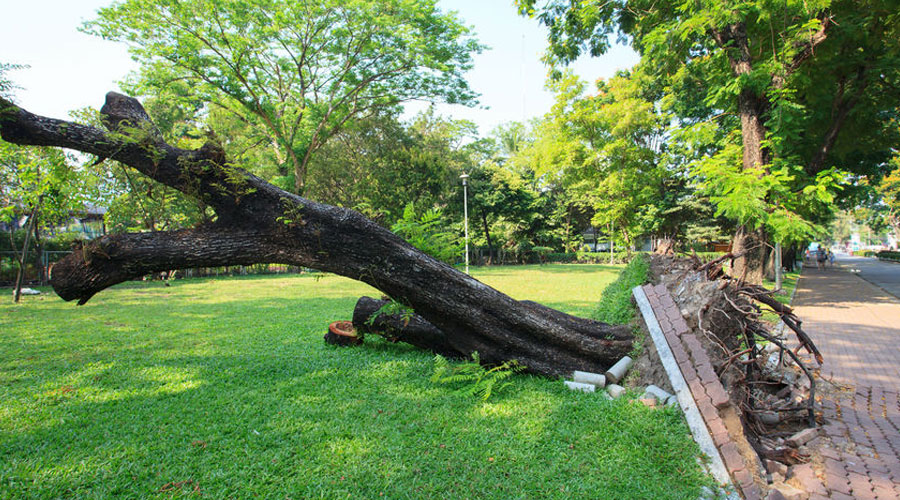During this season inclement weather can cause numerous trees and branches to fall, often onto adjacent properties. This can become a tricky situation, you may wonder who is responsible to clean up the damage? The answer can be complicated and varied dependent upon several factors. Below are some questions to consider:1. Who owns the tree? Pursuant to California Civil Code Section 833, if the trunk of a tree stands wholly on the land of one landowner, that landowner owns the tree regardless of whether its roots, foliage, or branches have grown onto the land of another. However, if the trunk of a tree stands partly on the land of two adjoining landowner, then both landowners own the tree. (Civil Code Section 834).
2. Is the tree’s owner liable for any damage? Not necessarily. It is the responsibility of every property owner to maintain their property, including trees, in safe hazard free conditions. The owner of the tree may be responsible for damage caused to a neighbor’s property, but only if it can be found that the tree’s owner failed to properly maintain the tree. Generally, such failure can be considered “negligence” and a negligent owner can be liable for all damages resulting from their neglect. However, in general the damaged party still must prove that the owner was negligent. For example, was the tree dead or dying from an insect infestation? Or did the owner trim the tree on his side only and thus render the tree unstable? If the tree’s owner failed to act “reasonably” in periodical inspections and maintaining their trees, they may be held liable for subsequent damage to others.
3. What about an “Act of God”? An Act of God is an unforeseeable event, i.e.: heavy storms, wind, lightning, that causes trees or limbs to fall. We commonly see this term as an exclusion from insurance policy coverage. However, an act of God is not always a successful defense from liability particularly if there has been personal injury or significant property damage. Court’s may often find sufficient evidence that the tree’s owner was somehow negligent and thus provide recourse for the injured party. Such a finding will typically utilize the property owner’s insurance coverage.
4. What about branches and debris that falls into the adjacent property? It is not an uncommon occurrence for a neighbor’s trees to drop leaves, fruit, branches, or even limbs onto their property. If there is no physical damage, California law does not provide any relief for the offended neighbor – unless they can prove the tree was improperly maintained. For branches and debris, the cost of legal action can easily exceed the cost of clean-up. While the neighbor cannot force the tree’s owner to clean up or be reimbursed, a co-operative approach may be the best option for both parties to employ.
5. Can a property owner use “self-help” to stop damage from a neighbor’s trees? California law is clear that a neighbor must act “reasonably” in trying to stop actual or potential damage from a neighbor’s trees. If the tree is causing actual damage such as roots uplifting a deck or branches pushing down a fence, the owner can be held liable for “nuisance”, that is allowing his use of his property to damage the property of another.
Simply cutting off encroaching tree roots or branches may kill the tree or render it unstable and dangerous thus exposing the cutter to substantial legal liability for all damage including replacement of the damaged tree. No such action should be undertaken without first seeking to get the tree’s owner to remedy the problem. If they refuse, then the neighbor should engage the services of a licensed arborist to trim the roots and branches is such a way as to reduce the property damage while not injuring the tree. If this cannot be done, then the neighbor should bring a legal action against the tree’s owner for nuisance which could compel him to trim or even remove the tree and repair any damage.
6. Must a seller disclose an offending tree? If a person is selling a home and there is any history of problems with adjacent trees, this should always be disclosed even if there has been no actual physical damage. Giant oak trees can provide great shade and color, but the leaves may fall everywhere creating a clean-up issue. The rule should always be: if the Seller thinks that this has been an issue, it would be reasonable to conclude that their buyer will likely feel the same way. Absent of disclosure, the Seller could be looking at a non-disclosure lawsuit when the new Buyer must start raking leaves every weekend.
This article is not intended to be legal advice, and should not be taken as legal advice. Every situation requires review of specific facts and history, and a formal agreement for service. This is provided to give a general idea of situations that may occur. Sources taken from the
Sources list:
http://realestate.findlaw.com/neighbors/neighbor-disputes-trees.html


